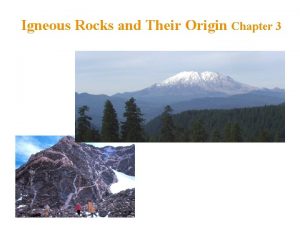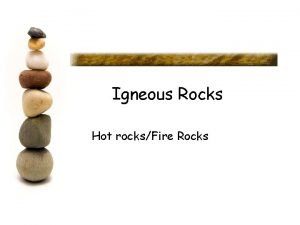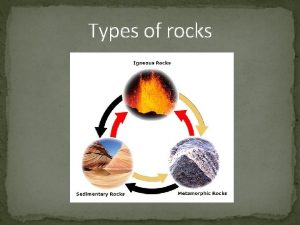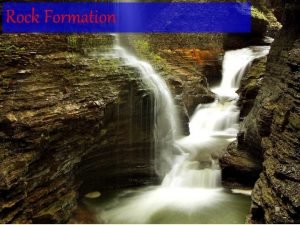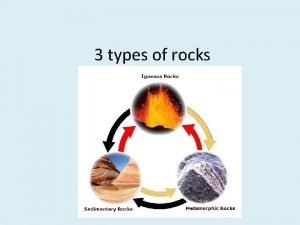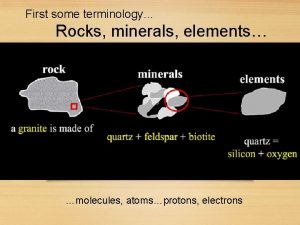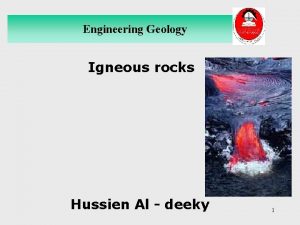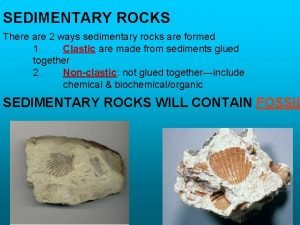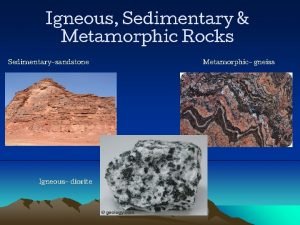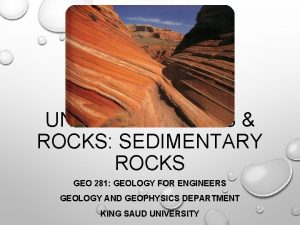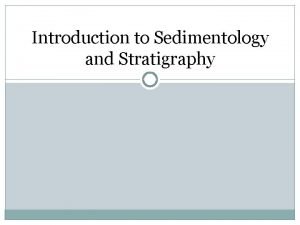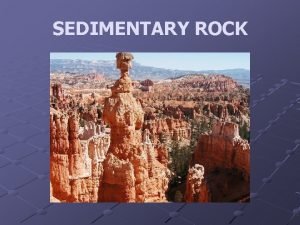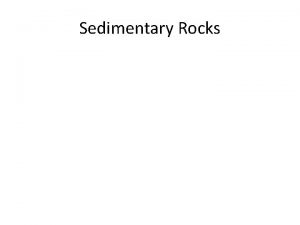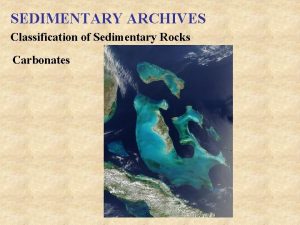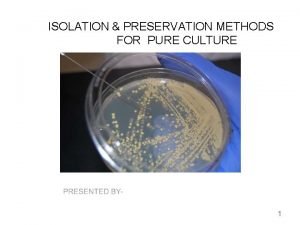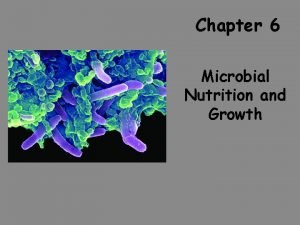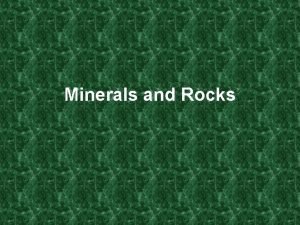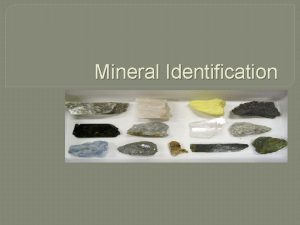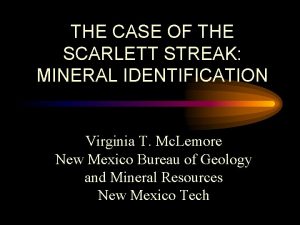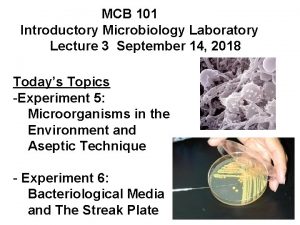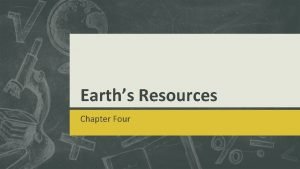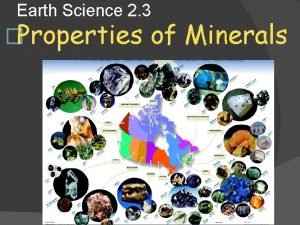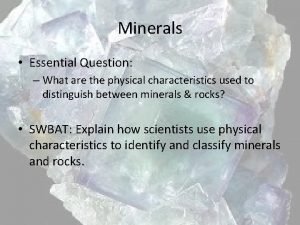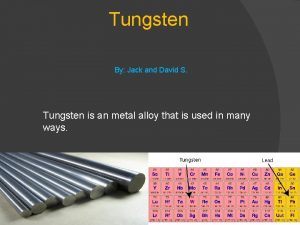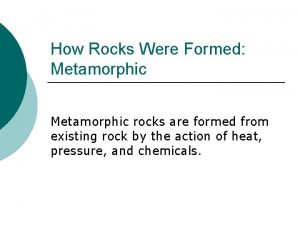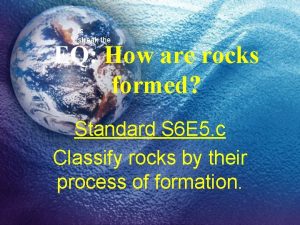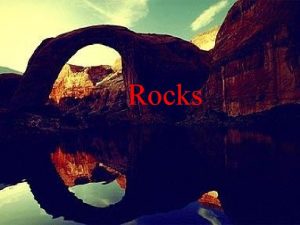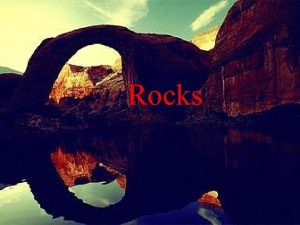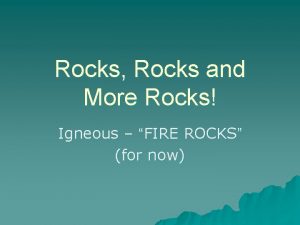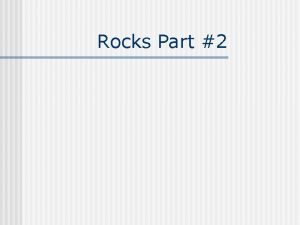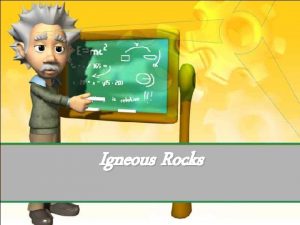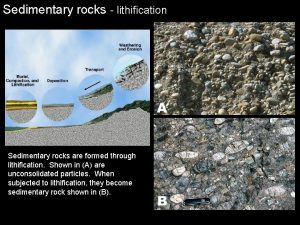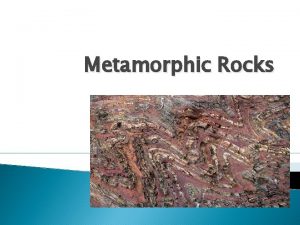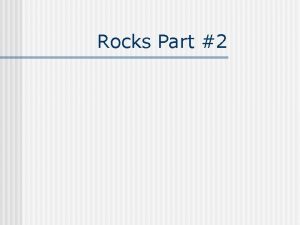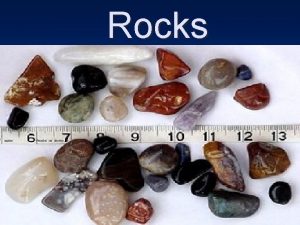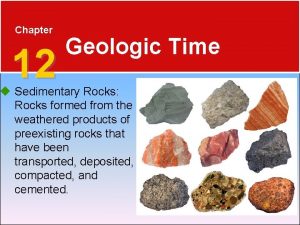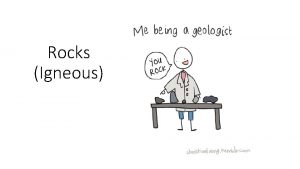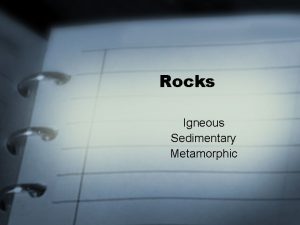ls streak the EQ How are rocks formed



















































































- Slides: 83

ls streak the EQ: How are rocks formed? Standard S 6 E 5. c Classify rocks by their process of formation.

EQ: How Are Rocks Classified? • What three characteristics do scientists use to identify rocks? • What are three groups into which geologists classify rocks? • What is a rock’s texture? • What do the three major groups of rock have in common? How are they different?

How geologists Classify Rocks • Rocks are made of minerals and a mixture of other materials • Some rocks are made of a single mineral • When studying a rock sample, geologists observe the rock’s texture, origin and mineral composition

A Rock’s Texture • A rock’s texture is the size, shape, and pattern of the rock’s grains Grain Size a. fine-grained (small-basalt) b. coarse-grained (large-granite) Grain Shape a. smooth and rounded (conglomerate) b. jagged (breccia) Grain Pattern a. foliated (gneiss) -lie in flat layers -wavy, swirling patterns b. nonfoliated (marble) c. looks like rows of multicolored beads d. occur randomly No Visible Grain a. have no apparent grains . vy,

Mineral Composition • By looking at a small sliver of a rock under a microscope, geologists can observe the size and shape of the crystals and identify the minerals the rock contains • Also, geologists can do tests to identify the physical properties of the minerals inside the rock. • • mafic= dark-colored rocks (poor in silica) (basalt) felsic = light-colored rocks (rich in silica) (granite)

Rock Origin how and where the rock was formed 1. igneous rock = forms from the melting, cooling and hardening of molten rock a. extrusive= formed above the surface (lava) b. intrusive = formed below the surface (magma) 2. sedimentary rock = forms in layers from other rocks, plants, and animals through a process of weathering, erosion, deposition, compaction and cementation a. clastic rock b. organic rock c. chemical rock 3. metamorphic rock = formed when existing rock is changed by heat, pressure, or chemical reactions a. foliated rock b. nonfoliated rock

Compare and Contrast Rocks Compare – Rocks in each group make up the Earth’s crust and are composed of minerals and other materials Contrast – Rocks are different in the way they are formed

How do igneous rocks form? • What characteristics are used to classify igneous rocks? • Describe three (3) ways in which igneous rocks differ. • What is the difference between extrusive and intrusive rocks? Give an example of each. • Why are some igneous rocks dark and others light?

Origins of Igneous Rock • Igneous rocks are classified by their origin. • Igneous rocks are classified by the texture of the grains • Igneous rocks are classified by the mineral composition of the rock • Igneous rock forms when magma cools and hardens. • Three ways magma can form: – heat/rise in temperature – pressure released – rock changes composition

Composition and Texture of Igneous Rock • Igneous rocks differ from one another in what they are made of, how fast they are cooled and where the rocks form. • Composition – • Igneous rock that is rich in silicon and lightcolored are called felsic rock. • Igneous rock that is poor in silicon and darkcolored are called mafic rock. • Texture – – Fine-grained (small) = cools quickly – Coarse-grained (large) =cools slowly

Origin of Formation • Igneous rock formations are located below and above Earth’s surface. • Intrusive igneous rock – Intrusive rock (granite) forms when magma hardens (beneath) Earth’s surface. – coarse-grained (large grains) – below Earth’s surface – ex. granite • Extrusive igneous rock – Extrusive rock (basalt) forms from lava that has erupted (onto) Earth’s surface. – fine-grained (small grains) – on the Earth's surface – ex. basalt

How do igneous rocks form? • Igneous rocks are classified according to their origin, texture, and mineral composition. • Igneous rocks form either from lava, above the earth’s surface or magma, below the earth’s surface. • They also differ in texture according to the size and shape of their mineral grains. (course-grained or fine-grained) • Igneous rocks differ in mineral composition depending on how much silica and other minerals are present. (felsic or mafic) • Dark igneous rocks form from magma or lava low in silica content (mafic). • Light igneous rocks form from magma high in silica content (felsic). • Light-colored rocks are less dense than the dark-colored rocks.

Uses of Igneous Rock • Most igneous rocks are hard, dense, and durable. • Ancient Native Americans used obsidian for making very sharp tools for cutting and scraping. • Granite is used as a building material such as decorative stonework, curbstones, and floors. . • Basalt is crushed to make gravel. • The rough surface of pumice makes a good abrasive for cleaning and polishing. • Perlite is often mixed with soil for starting vegetable seeds.

Quick Check 1. Which of the following are ways magma is formed? a. b. c. d. by compaction and cooling by melting and cooling by changes in composition by weathering and erosion

Quick Check 2. What kind of texture does igneous rock have when magma cools slowly? a. b. c. d. coarse-grained large-grained fine-grained medium-grained

Quick Check 3. What kind of texture does igneous rock have when magma cools rapidly? a. b. c. d. coarse-grained medium-grained large-grained fine-grained

Quick Check 4. What kind of rock is formed when magma intrudes into other rock? a. b. c. d. extrusive igneous rock sedimentary rock intrusive igneous rock organic sedimentary rock

Quick Check 5. What kind of rock is formed from lava that cools on Earth’s surface? a. organic sedimentary rock b. sedimentary rock c. intrusive igneous rock d. extrusive igneous rock

How is sedimentary rock formed? • Describe the origin of sedimentary rock. • Describe three main categories of sedimentary rock. • Describe three types of sedimentary structures.

What is sedimentary rock? • Sedimentary rocks form from particles deposited by water and wind. • After sediment has been deposited, the processes of compaction and cementation change the sediment into sedimentary rock.

Forming of Sedimentary Rock • Weathering- the breaking down of rock • Erosion – occurs when running water or wind loosen and carries away fragments of rock. • Deposition- the process in which sediment settles out of the water or wind carrying it. • Compaction- the process that presses sediment together. • Cementation- the process in which minerals crystallize and glue particles of sediment together.

Types of Sedimentary Rock • Geologists classify sedimentary rocks according to the type of sediments that make up the rock. • There are three major groups of sedimentary rocks: clastic rocks, organic rocks, and chemical rocks.

Clastic Rocks • A clastic rock is a sedimentary rock that forms when rock particles are squeezed together. • Examples of clastic rocks: – – Shale Sandstone Conglomerate Breccia

Clastic Rock: Shale • Shale forms from tiny particles of clay. • Shale feels smooth, and splits easily into flat pieces

Clastic Rock: Sandstone • Sandstone forms from the sand on beaches, on the ocean floor, in riverbeds, and in sand dunes. • Sandstone is formed when small particles of sand are pressed and cemented together. • .

Clastic Rock: Conglomerate and Breccia • Conglomerate is a rock made up of large particles with rounded edges. • Breccia is a rock made up of large fragments with sharp edges.

Organic Rocks • Organic rock forms from the remains of plants and animals and are deposit in thick layers. • The term “organic” refers to substances that were once part of living things. • Three important organic rocks: – Coal – Limestone – Chalk

Organic Rock: Coal • Coal forms from the remains of swamp plants buried in water. • Over millions of years, they slowly change into coal.

Organic Rock: Limestone • The hard shell of living things produces limestone. • Chalk forms from sediments made of skeletons of microscopic living things found in the ocean.

Chemical Rocks • Chemical rock forms when minerals that are dissolved in a solution crystallize. • Chemical rocks can also form when mineral deposits left when seas or lakes evaporate. • Examples: – Rock salt – gypsum

Sedimentary Rock Structures • The most important feature of sedimentary rock is stratification. • Stratification is the process in which sedimentary rocks are arranged in layers. • Strata differ from one another depending on the kind, size, and color of their sediment. • Ripple marks (1) are made by the motion of wind and water waves on lakes, oceans, rivers, and sand dunes. • Mud cracks (2) form when fine-grained sediments at the bottom of a shallow body of water are exposed to air and dry out. • Rain-drop (3) impressions can be preserved in finegrained sediments, as small pits with raised rims.

Uses of Sedimentary Rocks • Sandstone and limestone are used as building materials. • The White House in Washington, D. C. is built of sandstone. • Limestone is also used to make cement.

Quick Check 1. Which process forms sediment? a. b. c. d. weathering cementation compaction deposition

Quick Check 2. What are strata? a. b. c. d. mineral fragments minerals crystallized out of solution layers in sedimentary rock fossils in sedimentary rock

Quick Check: Sedimentary Rock 3. What kind of sedimentary rock is made of fragments of rocks cemented together by a mineral? a. b. c. d. organic stratified chemical clastic

Quick Check 4. What kind of sedimentary rock is made from solutions of dissolved minerals in water? a. b. c. d. organic chemical stratified clastic

Quick Check 5. What kind of sedimentary rock is made from fossils? a. b. c. d. organic stratified chemical clastic

Quick Check 6. What is the process called in which sedimentary rocks are arranged in layers? a. b. c. d. erosion extrusion weathering stratification

How is metamorphic rock formed? • How are metamorphic rocks formed? • Describe two ways a rock can undergo metamorphism. • Describe the difference between foliated and nonfoliated metamorphic rock.

How Do Metamorphic Rocks Form? • Metamorphic rock is formed when existing rock is changed by heat, pressure, or chemical reactions. • Heat and pressure deep beneath Earth’s surface can change any rock into metamorphic rock. • Metamorphic rocks are classified by the arrangement of their mineral grains.

Textures of Metamorphic Rock • The two types of metamorphic rocks are called foliated rock and non-foliated rock. • Foliated rock is when the grains are parallel or arranged in planes or bands. – gneiss (from granite) – Slate (from shale) • Non-foliated rock refers to where the grains are arranged randomly. – Marble (from limestone) – Quartzite (from sandstone)

Foliated Metamorphic Rock » » » • Schist Gneiss

Nonfoliated Metamorphic Rocks Quartzite Marble

Composition of Metamorphic Rock • Metamorphism occurs when temperature and pressure inside the Earth’s crust change. • Minerals that were present in the rock when it formed may not be stable in the new temperature and pressure conditions. • The original minerals change into minerals that are more stable in these new environment. • Some metamorphic minerals form only at certain temperatures and pressures. • Common metamorphic rock: slate, schist, marble, and gneiss.

Metamorphic Rocks • The texture or mineral composition of a rock can change when its surroundings change. • If the temperature or pressure of the new environment is different from the one in which the rock formed, the rock will undergo metamorphism. • Two ways that rock can undergo metamorphism are by contact metamorphism and regional metamorphism. • Contact metamorphism happens near bodies of magma. • Regional metamorphism occurs within Earth’s crust when pressure builds up in rock very deep below other rock formations

Metamorphic Rock Structures • Metamorphic rock has features that tell you about its history. • In metamorphic rocks, these features are caused by deformation. • Deformation is a change in the shape of a rock caused by a force placed on it. • These forces may cause a rock to be squeezed or stretched. • Folds or bends in metamorphic rock are structures that indicate that a rock has been deformed.

Uses of Metamorphic Rock • Marble and slate are the two most useful metamorphic rocks. • Marble can be cut into thin slabs and easily polished (Taj Mahal). • Slate , because it is foliated, splits easily into flat pieces. • Slate is used for flooring, roofing, outdoor walkways, or chalkboards. • Marble and Slate both come in a variety of colors.

Summary… • There are 3 major rock groups: igneous rocks sedimentary rocks and metamorphic rocks. • Igneous rocks form when molten rock cools and hardens from magma or lava. • Sedimentary rocks form from particles deposited, pressed, and cemented together by water and wind. • Metamorphic rocks form from heat and pressure, or a chemical reaction. • Forces inside Earth and at the surface produce a rock cycle that builds, destroys, and changes the rocks in the crust.

Quick Check 1. How does metamorphic rock form? a. by intense heat and pressure b. erosion, deposition, compaction, cementation c. melting into lava or magma, then cooling into a new rock d. by pressing together and then cementation

Quick Check 2. Molten rock beneath Earth’s surface is called a. b. c. d. lava. magma. sedimentary rock. igneous rock.

Quick Check 3. If you wanted to duplicate conditions in a laboratory that produced metamorphic rock from sedimentary rock, what would you need to do? a. apply pressure to the rock b. apply high temperature to the rock c. apply high pressure and high temperature to the rock d. let the rock stand under water for a long time

Quick Check 4. Which of the following is a metamorphic rock? a. b. c. d. granite sandstone limestone marble

Quick Check 5. Metamorphic rocks can be formed from a. igneous rocks. b. sedimentary rocks. c. metamorphic rocks. d. all rock groups.

Quick Check 6. The rock formed when granite changes to a metamorphic rock is a. marble. b. basalt. c. gneiss. d. pumice.

Quick Check 7. Metamorphic rocks that have their grains arranged in parallel bands or layered are said to be a. jagged grained. b. foliated. c. nonfoliated. d. coarse grained.

Quick Check 8. The heat that changes a rock into metamorphic rock comes from a. friction of plate movement. b. the sun. c. the heat of the mantle. d. chemical rocks in the crust.

Quick Check 9. Geologist classify metamorphic rock according to • A. the exterior color of the rock. • B. the overall shape of the rock. • C. the arrangement of the grains that make up the rock. • D. the degree of hardness of the rock.

Quick Check 10. Which type of rock is MOST LIKELY to form layers? • • A. B. C. D. Sedimentary Igneous Metamorphic magma

Quick Check 11. The _____ of a rock is determined by the sizes, shapes, and positions of the minerals the rock contains. 12. ____ metamorphic rock contains minerals that are arranged in plains or bands. 13. The most characteristic property of sedimentary rock is _____.

Quick Check 14. Sedimentary rock is classified into all of the following main categories except _____. a. clastic sedimentary rock b. chemical sedimentary rock c. nonfoliated sedimentary rock d. organic sedimentary rock

Quick Check 15. An igneous rock that cools very slowly has a _____ texture. a. foliated b. fine-grained c. nonfoliated d. coarse-grained

Quick Check 16. Igneous rocks form when a. minerals crystallize from a solution. b. sand grains are cemented together. c. magma cools and solidifies. d. mineral grains in a rock recrystallize.

Quick Check 17. A _____ is a common structure found in metamorphic rock. a. ripple mark b. fold c. sill d. layer

Quick Check 18. The process in which sediment is removed from its source and transported is called ______. a. deposition. b. erosion. c. weathering. d. uplift.

Quick Check 19. Mafic rocks are a. light-colored rocks rich in calcium, iron, and magnesium. b. dark-colored rocks rich in aluminum, potassium, silica, and sodium. c. light-colored rocks rich in aluminum, potassium, silica, and sodium. d. dark-colored rocks rich in calcium, iron, and magnesium.

EQ: What is the rock cycle? • What materials are rocks made of? • Describe four processes that change rock from one type to another. • What are three main classes of rock? • Describe two characteristics of rock that are used to help classify it?

What materials are rocks made of? • Rock is describe as a naturally occurring solid mixture of one or more minerals and organic matter. • Rocks are made of mixtures of minerals and other materials, although some rocks may contain only a single mineral. • When studying a rock sample, geologists observe the rock’s origin, color and texture and determine its mineral composition.

What materials are rocks made of? • Texture is described with terms based on grain size, grain shape, and grain pattern. • Most rocks are made up of tiny particles of minerals or other rocks, which are called grains. • A rock’s grains give it its texture. • There are three major groups of rocks: igneous rock, sedimentary rock, and metamorphic rock. • These terms refer to how the rocks in each group were formed (origin).

The Rock Cycle • The rock cycle is a series of processes in which a rock forms, changes from one type to another, is destroyed, and forms again by geological processes. • Rocks have been used by humans to make tools and weapons and to construct buildings.

Processes That Shape the Earth • Certain geological processes make and destroy rock. • These processes shape the features of the Earth. • Theses processes also influence the type of rock that is found in a certain area of Earth’s surface.

Processes That Shape the Earth • Weathering is the process by which water, wind, ice, and heat break down rock. • Erosion is the process by which sediment is removed from its source. • Deposition is the process by which sediment moved by erosion is laid down. • Uplift is the process by which rock within the Earth moves to Earth’s surface.

Illustrating the Rock Cycle • Igneous rock is formed when magma or lava is cooled and hardens and solidifies. • Sedimentary rock is formed by the process of weathering, erosion, deposition and compaction and cementation. • Metamorphic rock is formed by heat, pressure or chemical change beneath Earth’s surface.

Rock Classification • Scientists classify rocks in detail by using two important criteria – composition and texture. • Composition is the chemical makeup of a rock; describes either the minerals or other materials in the rock. • Texture is the quality of a rock based on the sizes, shapes, and positions of the rocks grains.

Quick Check 1. Which of the following rocks is not normally used as a construction material? a. b. c. d. marble halite limestone granite

Quick Check 2. The process in which wind, water, ice, and heat break down rock is called a. b. c. d. uplift. intrusion. recystallization. weathering.

Quick Check 3. What forms when rock partially or completely melts? a. b. c. d. limestone reefs ripple marks magma

Quick Check 4. Scientists classify rocks a. b. c. d. by composition and texture. by volume. by mass. by color and size.

Quick Check Solid mixture of one or more minerals and organic matter: a. composition b. rock c. erosion d. texture e. rock cycle f. deposition

Quick Check Process by which new rock forms from old rock: a. composition b. rock c. erosion d. texture e. rock cycle f. deposition

Quick Check Process by which sediment is removed from its source: a. composition b. rock c. erosion d. texture e. rock cycle f. depositi

Quick Check Process by which sediment is dropped and comes to rest: a. composition b. rock c. erosion d. texture e. rock cycle f. depositi

Quick Check The chemical makeup of a rock: a. composition b. rock c. erosion d. texture e. rock cycle f. deposition

Quick Check Size, shape, and position of grains that make up a rock: a. composition b. rock c. erosion d. texture e. rock cycle f. deposition
 Insidan region jh
Insidan region jh Types of igneous sedimentary and metamorphic rocks
Types of igneous sedimentary and metamorphic rocks Igneous metamorphic and sedimentary
Igneous metamorphic and sedimentary Primitive streak gives rise to
Primitive streak gives rise to How igneous rocks are formed
How igneous rocks are formed How are igneous rocks formed
How are igneous rocks formed Marble rock characteristics
Marble rock characteristics Intrusive igneous rocks crystal size
Intrusive igneous rocks crystal size Silicon oxygen tetrahedron
Silicon oxygen tetrahedron How do igneous rocks form
How do igneous rocks form Properties of a sedimentary rock
Properties of a sedimentary rock Sedimentary rocks examples
Sedimentary rocks examples Metamorphic rocks are formed where
Metamorphic rocks are formed where How are sedimentary rocks formed
How are sedimentary rocks formed Igneous rock formation
Igneous rock formation Clastic sedimentary rocks
Clastic sedimentary rocks Metamorphic rocks images with names
Metamorphic rocks images with names Chemical sedimentary rocks formed
Chemical sedimentary rocks formed What are sedments
What are sedments Process of formation of sedimentary rocks
Process of formation of sedimentary rocks How rocks form
How rocks form Sedimentary rock cycle
Sedimentary rock cycle How are sedimentary rocks formed
How are sedimentary rocks formed Extrusive rocks and intrusive rocks
Extrusive rocks and intrusive rocks Rhyolite vs basalt
Rhyolite vs basalt Overlap gate injection molding
Overlap gate injection molding Spread plate vs pour plate
Spread plate vs pour plate Chapter 6 microbial nutrition and growth
Chapter 6 microbial nutrition and growth Luster and streak
Luster and streak Streak plate technique ppt
Streak plate technique ppt Streak
Streak Streak of minerals
Streak of minerals Iv site complications
Iv site complications Radiant streaking method
Radiant streaking method Procedure of streak plate method
Procedure of streak plate method Gastrulation
Gastrulation Mineral streak
Mineral streak Sudden successive flights of bullets streak the silence
Sudden successive flights of bullets streak the silence Streak plate method
Streak plate method What is this
What is this Streak culture method
Streak culture method What is a person called who studies rocks
What is a person called who studies rocks Principle of sterilization
Principle of sterilization Streak properties of minerals
Streak properties of minerals 5 mineral characteristics
5 mineral characteristics Tungsten streak
Tungsten streak Các châu lục và đại dương trên thế giới
Các châu lục và đại dương trên thế giới Bổ thể
Bổ thể Từ ngữ thể hiện lòng nhân hậu
Từ ngữ thể hiện lòng nhân hậu Tư thế ngồi viết
Tư thế ngồi viết Thế nào là giọng cùng tên
Thế nào là giọng cùng tên Làm thế nào để 102-1=99
Làm thế nào để 102-1=99 Thơ thất ngôn tứ tuyệt đường luật
Thơ thất ngôn tứ tuyệt đường luật Hát lên người ơi
Hát lên người ơi Hổ đẻ mỗi lứa mấy con
Hổ đẻ mỗi lứa mấy con đại từ thay thế
đại từ thay thế Diễn thế sinh thái là
Diễn thế sinh thái là Vẽ hình chiếu vuông góc của vật thể sau
Vẽ hình chiếu vuông góc của vật thể sau Công thức tính độ biến thiên đông lượng
Công thức tính độ biến thiên đông lượng Tỉ lệ cơ thể trẻ em
Tỉ lệ cơ thể trẻ em Thế nào là mạng điện lắp đặt kiểu nổi
Thế nào là mạng điện lắp đặt kiểu nổi Lời thề hippocrates
Lời thề hippocrates Vẽ hình chiếu đứng bằng cạnh của vật thể
Vẽ hình chiếu đứng bằng cạnh của vật thể Quá trình desamine hóa có thể tạo ra
Quá trình desamine hóa có thể tạo ra Các môn thể thao bắt đầu bằng từ đua
Các môn thể thao bắt đầu bằng từ đua Khi nào hổ mẹ dạy hổ con săn mồi
Khi nào hổ mẹ dạy hổ con săn mồi Hát kết hợp bộ gõ cơ thể
Hát kết hợp bộ gõ cơ thể Dot
Dot điện thế nghỉ
điện thế nghỉ Thế nào là sự mỏi cơ
Thế nào là sự mỏi cơ Trời xanh đây là của chúng ta thể thơ
Trời xanh đây là của chúng ta thể thơ độ dài liên kết
độ dài liên kết Chó sói
Chó sói Thiếu nhi thế giới liên hoan
Thiếu nhi thế giới liên hoan Phối cảnh
Phối cảnh Một số thể thơ truyền thống
Một số thể thơ truyền thống Thế nào là hệ số cao nhất
Thế nào là hệ số cao nhất Sơ đồ cơ thể người
Sơ đồ cơ thể người Thế nào là số nguyên tố
Thế nào là số nguyên tố đặc điểm cơ thể của người tối cổ
đặc điểm cơ thể của người tối cổ Mật thư anh em như thể tay chân
Mật thư anh em như thể tay chân Các châu lục và đại dương trên thế giới
Các châu lục và đại dương trên thế giới Tư thế worm breton là gì
Tư thế worm breton là gì




